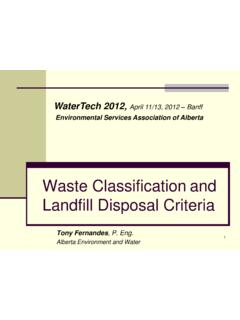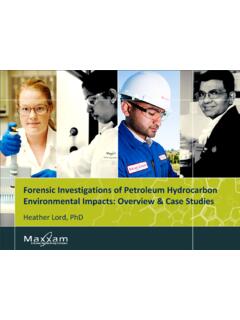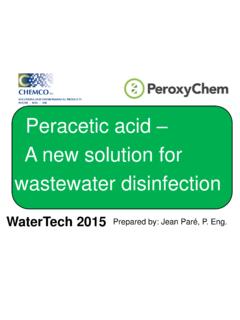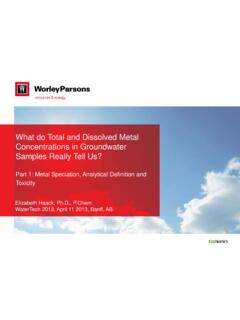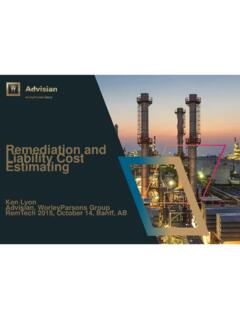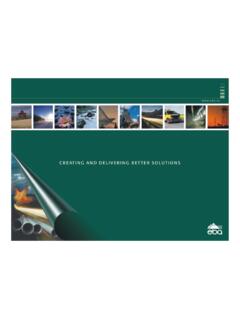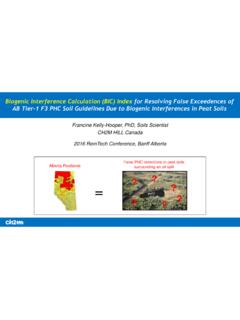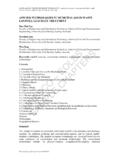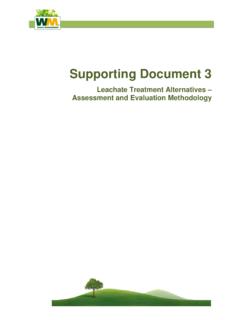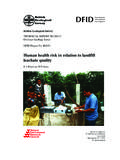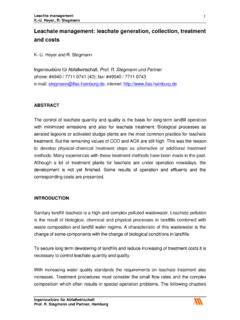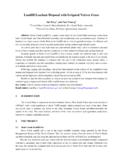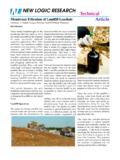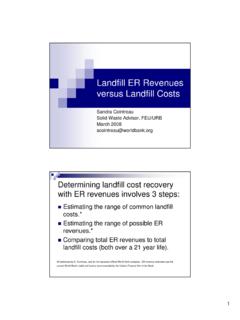Transcription of Waste Classification and Landfill Disposal Criteria
1 1 Waste Classification and Landfill Disposal Criteria Tony Fernandes, P. Eng. Alberta Environment and Water WaterTech 2012, April 11/13, 2012 Banff Environmental Services Association of Alberta 2 Waste Classification Waste identification, characterization, and Classification are the critical steps in determining the appropriate management of a Waste . 3 Classification and Land Disposal Waste Control Regulation Alberta User Guide for Waste Managers ERCB Directives 058 AEW Policy ES-00-PP9 ( Landfill Disposal of HW) AEW Policy ES-99-PP1 (Deepwell Disposal ) ERCB Directive 051 4 5 Why Testing a Waste ?
2 Legal Requirements (EPEA & WCR) Classification /Management Transportation (EPEA, TDGR, & EIHWHMR) Storage (OHS & EPEA) Treatment/BUW/AIP Disposal (landfills, deepwells, & thermal destruction) 6 When Testing Is Not Required? Regulatory Reasons [Schedule 2, s 1(h)] Generator Knowledge Previous Testing (Totals, Rule of Thumb, TCLP, etc.) Understanding the Process MSDS 7 8 Waste Classification STEP 1 - Is the substance a Waste ? (or a Recyclable?) product or material derived from Waste , dust suppressing agents, fluids used to maintain oil/gas reservoir pressure, or soil conditioning agents.
3 _____ Oilfield Waste - Waste produced by the upstream oil and gas sector (OGCA, Regulations, and Directives) _____ 9 Waste Classification STEP 2 - Is the Waste excluded? , not regulated as HW because it is listed in Schedule 2 of the WCR (not regulated as HW) , or Part 1A of the Guide, pages 9-23 _____ (Examples: drained oil filters, CKD, ashes from fossil fuels, TV, computers, fluorescent light lamps, etc.) _____ (AB Legislation) (User Guide) 10 Waste Classification Substances not regulated as HW (listed in the Guide, Part 1A, pages 9-23): TDGR p wastes Common substances that may present hazardous characteristics (such as activated carbon, asbestos, fabrics, straw, petroleum crude, etc.)
4 But have been de-listed by the Basel, OECD, or AENV. 11 Waste Classification STEP 3 - Is the Waste listed in Tables 3 or 4 of the Guide? Table 3 ( Waste types from specific and non-specific sources, and AB series) Table 4 (off-spec chemicals 4A and 4B and containers) _____ 12 Waste Classification STEP 4 Does the Waste show any of the characteristics identified in Schedule 1 of the WCR? Flammable ( 60 oC)1 Class 3 or 4 Reactive (includes oxidizers) Class 4 or 5 Corrosive (pH < 2 or pH > ) Class 8 Toxic (acute or chronic) Class or Class PCB 50 mg/kg, D&D, containers, empty containers, D&D _____ 1 Reference to TDGR recent changes ( & class 9).
5 13 Flammable Waste1 Liquids: < 60o C, closed cup test (class 3, flammable liquids) Solids contaminated with flammable liquids: < 60o C, closed cup test but disconnect the stirrer (class flammable solids) Readily combustible solids: combustible burn test / burning rate test (class , flammable solids S Waste ) Spontaneously combustible solids: test for pyrophoric or self heating substances (class , flammable solids) Solids that in contact with H2O emit a flammable gas or spontaneously ignite (class , water-reactive substances) _____ 1 TEST METHODS: - Alberta User Guide for Waste Managers, 1995 - ERCB Directive 58, 1996 TDGR Interim Compilation of Test Methods, Environment Canada, 1988.
6 - Recommendations on the Transport of Dangerous Goods, Manual of Tests and Criteria , 5th edition, 2005 14 Toxic Waste Acute It is an acute toxic Waste because it has an oral toxicity LD50 500 mg/kg (liquids) or 200 mg/kg (solids)1, a dermal toxicity LD50 1000 mg/kg, or an inhalation toxicity LC50 10 000 mg/m3 at NPT _____ 1 The 1993 and 1996 versions of the WCR stipulated an oral toxicity LD50 5000 mg/kg with no distinction between liquids and solids. 15 Toxic Waste Chronic (leachable) It is toxic because it is in a dispersible form and produces a toxic leachate1 that has one or more of the chemicals in Table 1 at levels 100 mg/L (former TDGR substances) chemicals in Table 2 at levels the indicated limits (former TDGR substances) _____ 1 The TCLP leachate results are expressed in milligrams of substance per liter of solution or leachate extract.
7 16 Disposal of Waste Dispose , when used with respect to Waste at a Landfill or by deepwell injection, means the intentional placement of Waste on or in land as its final resting place [s 1(p) WCR] 17 Land Disposal Landfill Classification (WCR) Class I Landfills, Class II Landfills, and Class III Deepwell Classification (D51) Class Ia, Class Ib, Class II, Class III, and Class IV 18 Landfill Disposal Class III Landfills (for inert Waste , only) Inert Waste means solid Waste that, when disposed of in a Landfill or re-used, is not reasonably expected to undergo physical, chemical or biological changes to such an extent as to produce substances that may cause an adverse effect, and includes, but is not limited to, demolition debris, concrete, asphalt, glass, ceramic materials, scrap metal and dry timber or wood that has not been chemically treated [WCR, s 1( )].
8 19 Landfill Disposal Class II Landfills (solid non-hazardous Waste , only) Waste pass applicable Criteria Show no core hazardous characteristics, and Pass the TCLP when applicable) Requires Waste Classification Core vs. TCLP leachable Waste Rule of Thumb (total conc. vs. TCLP leachate conc.) Units (mg/kg vs. mg/L) _____ 1 Reference to PCBs (< 50 mg/kg) and tabled limits for specific solvents, halogenated organic compounds, and metals. 20 Landfill Disposal of HW Class I Landfills (specific HW, s 13 WCR) Applies to solid HW, only. 13(2)(a) and 13(2)(b) HW w/ solvents and/or HOX1.
9 Combined concentration less than 1000 mg/kg .. 13(2)(c) Solid HW not ignitable, reactive, or corrosive under the conditions of Disposal 13(2)(d) Solid HW that produces a Waste extract w/ metal levels less than specific values in mg/L. _____ 1 Reference to PCBs (< 50 mg/kg) and tables for specific solvents, AOX and metals. 21 Landfill Disposal Rule of Thumb (worst case scenario): Total vs. TCLP leachates If the total concentration of the chemical of concern in a solid Waste (including excavated CS) expressed in mg/kg divided by twenty produces a number that is less than the corresponding value in Table 2 of the Guide, then the Waste is not a HW due to the presence of that constituent.
10 22 Landfill Disposal Rule of Thumb Representative soil samples from an industrial site show a total concentration for lead between 140 mg/kg and 600 mg/kg. Is the soil potentially hazardous? Assumptions: 20 is the dilution factor for the TCLP, and all the lead in the sample will be fully extracted into the TCLP leachate solution. Calculation (best scenario) 140 mg/kg/20 = mg/kg Assessment: mg/L > mg/L. From Table 2 of the User Guide we see that the WCR limit for Pb in Conclusion: This means that this soil potentially shows hazardous characteristics but still apparently suitable to be put to various uses.
